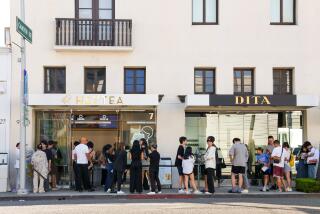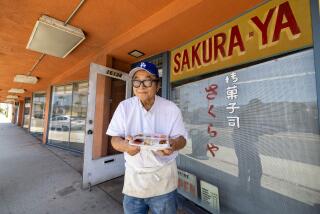TRUE Believer
Somewhere in Vernon, among rendering plants and metal furniture factories, G.T. Dave, a 30-year-old Beverly Hills High School dropout, and the 45 employees of his steadily growing beverage company, Millennium Products Inc., lovingly tend to a repulsive organism that’s reproducing like mad in a room with purple walls.
We can’t tell you exactly what it looks like. Or really anything about it. The fastidious and secretive Dave won’t let us see it.
For the record:
12:00 a.m. Feb. 3, 2008 For The Record
Los Angeles Times Wednesday, January 16, 2008 Home Edition Main News Part A Page 2 National Desk 2 inches; 73 words Type of Material: Correction
Kombucha tea: A graphic accompanying a Jan. 6 Los Angeles Times Magazine article on G.T. Dave, a purveyor of kombucha tea, said that the formula for fermentation is C6 H12 O6→ 2C2 H5 OH + 2CO2 (sugar yields ethanol + carbonic gas). This is the formula for one type of fermentation. G.T. Dave’s fermentation formula for kombucha tea is C6 H12 06→C6 H10 07 + 2CO2 (glucose yields glucuronic acid + carbonic gas).
For The Record
Los Angeles Times Sunday, January 20, 2008 Home Edition Main News Part A Page 2 National Desk 2 inches; 73 words Type of Material: Correction
Kombucha tea: A graphic accompanying a Jan. 6 Los Angeles Times Magazine article on G.T. Dave, a purveyor of kombucha tea, said that the formula for fermentation is C6 H12 O6 2C2 H5 OH + 2CO2 (sugar yields ethanol + carbonic gas). This is the formula for one type of fermentation. G.T. Dave’s fermentation formula for kombucha tea is C6 H12 06C6 H10 07 + 2CO2 (glucose yields glucuronic acid + carbonic gas).
For The Record
Los Angeles Times Sunday February 03, 2008 Home Edition Los Angeles Times Magazine Part I Page 7 Lat Magazine Desk 1 inches; 67 words Type of Material: Correction
The graphic accompanying an article on kombucha tea (“True Believer,” Jan. 6) said that the formula for fermentation is C6 H12 O6 aUi 2C2 H5 OH + 2CO2 (sugar yields ethanol + carbonic gas). This is the formula for one type of fermentation. G.T. Dave’s fermentation formula for kombucha tea is C6 H12 06 aUi C6 H10 07 + 2CO2 (glucose yields glucuronic acid + carbonic gas).
The organism, a gelatinous melding of bacteria and yeast, is essential to the production of kombucha, a fermented tea that tastes a little like cider vinegar and has been credited with health benefits as varied as clearing up acne and boosting the immune systems of people with HIV. These claims aren’t backed by scientific research, but that hasn’t prevented supporters from latching on to kombucha as a cure-all--or kept Whole Foods and other national retailers from stocking GT’s Kombucha, available in two varieties and 13 flavors, on their shelves. (It sells for $3 to $4 a pop.)
“We went from carrying a few bottles that people weren’t quite sure what to make of, to whole shelves of the product that we could barely keep in stock,” says Marci Frumkin, marketing director for the southern Pacific region of Whole Foods Market. Another Whole Foods executive, senior global grocery coordinator Perry Abbenante, associates Dave’s products with “amazing sales,” adding, “GT’s Kombucha is one of our top beverage brands.”
For his part, George Thomas Dave insists that good vibes are essential for good business. A positive attitude--about kombucha’s effects and everything else--is crucial to the base organism’s well-being, he says.
“People’s energy has an influence on the quality of the kombucha,” he says, sitting near the door of a Beverly Hills coffee shop. Dave doesn’t order anything. Not even water. His dark hair is shiny. His build, medium and athletic. His teeth are a brilliant white, and his hazel eyes sparkle. He drives a BMW M5. He’s everything you’d want in a health food ambassador. “We had one employee who was suffering from depression. He had a heart attack, and in all the batches [that he was involved in], the quality dropped.”
New Age nonsense? Let’s see: Dave says he selects employees based on their energy and Zodiac signs. And there’s more. The clairvoyant who analyzed the dirt around his factory told him he was destined for greatness.
Dave seems utterly convinced of his own sales pitch when he reveals the driving motivaton behind his calling:
“I got into this because kombucha saved my mom’s life.”
G.T.’s parents, Laraine and Michael Dave, began brewing kombucha in their home in 1992, when G.T. was a freshman at Beverly Hills High. The wife of a local juice-store owner had given Michael a kombucha culture she said she had received from a monk. (Before companies such as Millennium Products came along, kombucha was mostly a grown-at-home endeavor with cultures passed from person to person.) She told the couple how to ferment the organism in a mixture of tea and sugar, the most common method of deriving a drinkable beverage. Dave’s parents and older brother, Adam, immediately took to the stuff, harvesting “babies” from the white gelatinous culture every 10 days, fermenting them in seven large glass bowls on their dining room table and marveling at the weight loss and feeling of well-being they attributed to this ancient Chinese blob.
But G.T. thought it was weird.
“Everyone who came over always asked, ‘What’s that smell?’” Dave recalls. “You’d take off the lids, and it burped at you. I thought, ‘Everyone thinks we’re the Addams Family.’”
His opinion of the concoction changed dramatically in 1994, when Laraine was diagnosed with breast cancer. She underwent a lumpectomy, followed by about a year of chemotherapy and radiation. But she credits kombucha with helping her beat the disease and preventing it from spreading--a point that is stressed in the marketing of GT’s Kombucha.
Dave is convinced that kombucha arrested Laraine’s cancer by boosting her immune system and flushing toxins from her body.
“My mother is and will always be my everything,” says Dave, who is single and living with Laraine until his new house on the Westside is finished. “The concept of her not being in my life shook me up. The idea that a health food helped her really spoke to me. It inspired me to think that something like this could help other people.”
At that time, Dave had gotten his GED, left high school and started taking business classes at Santa Monica College. His dad suggested that Adam bring kombucha to market, but he was a history student at UCLA at the time and never demonstrated a head for business. However, the youngest Dave brother took to kombucha like a calling.
With no knowledge of the inner workings of the beverage industry, the passionate G.T. simply dived right in. “This was his vehicle to really shine,” says Adam, a recent Louisiana State University medical school graduate. “He was always the kid who was bright but didn’t have the patience for academics.”
What he did possess was natural business acumen--and more than a little creativity.
The then-17-year-old was a one-man operation--brewing the tea, marketing it and delivering it himself. But nobody had to know that. From his bedroom, Dave placed calls to buyers, distributors and store owners, posing as different “employees” in his nascent operation.
“He’d use different voices depending on whom he was talking to,” Adam recalls. “I lived in the room next to his, and I’d hear him assume all these different identities. I thought it was charming.”
Dave, who sells more than a million bottles of his beverage a year, is no less charming today, proselytizing about the powers of kombucha with quiet earnestness.
“What I’m doing is not a trend, it’s not hype,” Dave says. “People are drinking it because of the deeply personal connection they have with it.”
Dave says kombucha resembles a flat mushroom and that it takes on the shape of the container in which it is cultured. Every 30 days a “baby” kombucha is created on top of the “mother.” If they meet Dave’s standards, these new cultures go on to brew their own batches. (Each culture has a life span of about 10 uses--after which it’s shipped off to become compost.) We’ll have to take his word for it. Its actual appearance remains a tightly guarded secret.
“I’m sorry,” he says, turning down yet another request for a meeting with the organism. “I’m just a really private person.”
“He has always been possessive and intense about things--to an extreme by his own admission,” Adam says. “He’s not comfortable unless he’s in total control of every facet of the business.”
As with many health foods and folk remedies, scientists are not convinced that kombucha works--or if it does, how. Proponents point to the tea’s probiotics--live organisms such as bacteria and yeast that they say help cleanse the body and move food through the digestive tract faster. Researchers have found that probiotics can restore digestive tract flora in people with diarrhea. However, skeptics note that home-brewed kombucha was implicated in the death of an Iowa woman in 1995, according to a Centers for Disease Control and Prevention study.
Dave says that when properly made, the hydroponic organism acts as a natural antibacterial agent, killing potential contaminants. Plus, he says his facility is scrubbed daily from top to bottom. “When health inspectors come in, their jaws drop at how clean everything is,” he says, and calls to the Vernon Health Department back him up.
But even if the tea isn’t harmful, the medical community doubts the benefits touted by its supporters.
“They make claims that it boosts the immune system, but what does that mean?” says Dwight Nance, a professor of physical medicine at UC Irvine and a researcher who studies the therapeutic effects of probiotics similar to the ones found in kombucha. “The immune system doesn’t work that way, like a thermostat, where more is warmer and good.”
Still, fans swear by it.
“It’s unbelievable,” says Juan Hernandez, 35, who manages the health food store Erewhon on Beverly Boulevard. “After you have lunch and eat heavy food, the kombucha breaks it down. It’s good for the hair, the nails and the eyes.”
Laraine’s cancer is not the only illness to have struck the Dave family. G.T.s’ other brother, Justin, succumbed to bone cancer in 1996. “If he had been drinking it, he would have survived,” Laraine says flatly. “We tried to sneak it into his smoothies, but he didn’t want it.”
Justin’s death occurred just as Dave’s company was taking off and a number of health food stores in Los Angeles had started selling his products. Although his brother’s death tore apart his parents’ marriage, Dave and his bacteria continued to flourish; he moved to his first factory in Gardena in 1997.
“After my mother and father split up, I didn’t know if there would be a home” to keep brewing in, Dave says. “A friend of my parents called and said he found a perfect place on Western and Rosecrans, and my first thought was, ‘Wait, weren’t the riots there?’”
Still, he put aside his anxiety and set up shop in the building, eventually expanding his operation until it filled the entire 2,000 square feet.
“The property owner loved me,” Dave says. Taking over the building one unit at a time wasn’t the most cost-effective way to expand, but Dave wanted to be careful and not grow his business too quickly. His kombucha cultures had to be harvested and cared for; the process, he insists, is a slow one.
The key to maintaining a good beverage is patience and scale, he says. This is achieved by culturing the kombucha over 30 days in small batches. Only after the tea is fully fermented does he add fresh fruit juices such as blueberry, cranberry or ginger.
His pace, however, has not slowed down his business. Kim Tonge, one of the first brokers of natural and organic products who helped persuade more markets to carry GT’s Kombucha, says business has grown beyond her expectations. Whole Foods took the product national nearly two years ago, making it the only kombucha beverage with such wide distribution.
“When I sat down with him, he didn’t know what a broker was,” says Tonge, president of New Connections Marketing Group, which approached Dave in 2002 after one of Tonge’s sales reps introduced her to the tea. “I said, ‘When this takes off, it is going to be huge.’ It took us a few months before it started flying. It’s not often you get a ride like this.” Dave himself confirms published reports that his products are now the leaders in a $34-million market.
Hernandez likes to remind Dave that he remembers him as a 17-year-old, walking into the store “holding 12 little bottles--8 ounces, all plastic. Now, I look at my shelf, there are 12 different flavors. Cranberry, strawberries, guava, ginger,” he says. “I can go through in a month maybe 20 cases of any other brand. GT’s Kombucha, I go through a pallet or two--that’s 120 cases.”
In 2005, Dave moved his operation to the 50,000-square-foot factory in Vernon. He signed a two-year lease and is contemplating expanding into the factory across the parking lot. Its floor plan is big and spacious, with high ceilings as in his current production facility. Dave will probably paint the walls of any new facility purple too.
The color, he says, is calming, setting a peaceful mood for the kombucha to grow.
Not that we’ve seen it.
--
(BEGIN TEXT OF INFOBOX)
THIS TO THAT / G.T. DAVE’S PROGRESSION
THE KITCHEN > THE OFFICE
In the beginning, Dave was a one-man show, operating out of his parents’ house and preparing kombucha in the kitchen.
Now he presides over a 45-employee operation and can afford to furnish his office in budding beverage-mogul style.
--
THE DINING ROOM > THE FACTORY
Dave’s mother and father were early adopters of kombucha, fermenting it on their dining table. Dave thought it was weird, but now he operates a 50,000-square-foot factory in Vernon, churning out so much kombucha that he needs forklifts to move it.
--
The Fungus > GT’s Kombucha
Kombucha is a fermented beverage. Sugar and tea provide fuel to a kombucha “mother” culture, which is a combination of bacteria and yeast. Dave has industrialized this process, with a vote of confidence from the Vernon Health Department and retail chains such as Whole Foods.
More to Read
Eat your way across L.A.
Get our weekly Tasting Notes newsletter for reviews, news and more.
You may occasionally receive promotional content from the Los Angeles Times.








